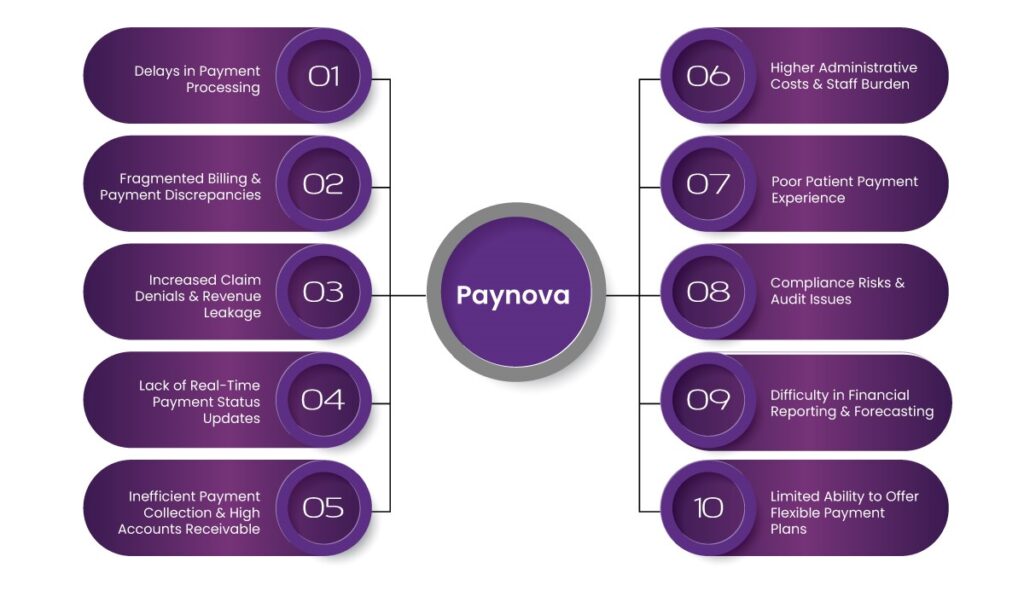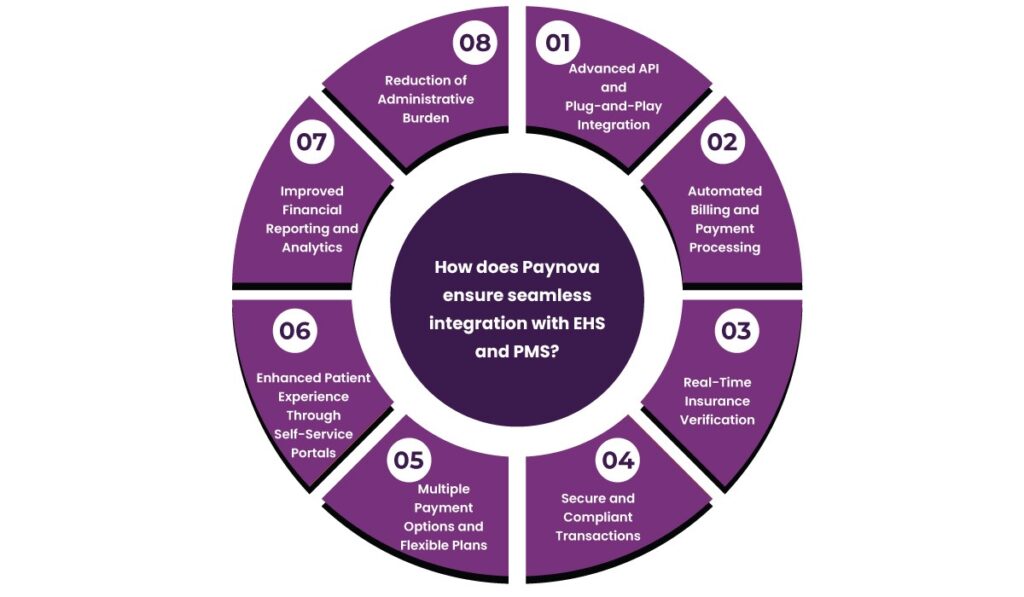Table of Contents
Introduction
Picture this: A doctor sees a patient, carefully updating their Electronic Health Record (EHR) with every vital detail. The diagnosis is clear, the treatment plan is set—but then, chaos unfolds at the billing desk. The front office scrambles through paperwork, manually entering payment details, chasing down insurance approvals, and struggling with errors that lead to claim denials. The patient, already overwhelmed, leaves with a confusing bill and a headache.
This isn’t just an inconvenience—it’s a system failure. Without seamless integration between EHR, Practice Management Systems (PMS), and Healthcare payment solutions, healthcare providers drown in inefficiencies. Payments are delayed, revenue leaks through the cracks, and patients grow frustrated.
Now, imagine a different reality: The doctor updates the EHR, and the system instantly syncs with the billing department. Insurance is verified in real time, invoices are generated automatically, and the patient gets a clear, accurate bill with flexible payment options. No delays. No confusion. Just seamless healthcare.
That’s the power of integration. Today, American healthcare providers can no longer afford to operate without it.
Challenges Faced by Healthcare Providers Due to Non-Integration of EHR & PMS with Healthcare payment solutions
When a healthcare provider fails to integrate its Electronic Health Record (EHR) and Practice Management System (PMS) with healthcare payment solutions, it creates significant operational, financial, and patient-related challenges. Below are ten major challenges explained in detail with real-world examples.
1. Delays in Payment Processing
Challenge:
Without integration, payment processing requires manual intervention, leading to delays in billing, insurance claims, and reimbursements.
Impact:
- Patients experience longer waiting times at checkout due to manual invoice generation.
- Insurance claims processing takes weeks instead of days.
- Healthcare providers struggle with cash flow due to slow payment collection.
Example:
A patient undergoes a surgery, but since the EHR is not linked with the Healthcare payment solutions, the billing team manually extracts treatment details and submits a claim to insurance. Due to errors in manually inputted codes, the claim is denied, delaying reimbursement for the hospital.
2. Fragmented Billing & Payment Discrepancies
Challenge:
With separate systems, billing information from EHR may not sync correctly with the Healthcare payment solutions, resulting in errors, duplicate charges, or missing charges.
Impact:
- Patients receive multiple invoices, leading to confusion and payment delays.
- Some services go unbilled, causing revenue loss.
- Administrative burden increases due to billing disputes and corrections.
Example:
A patient visits a clinic for a consultation and diagnostic test. The consultation is billed immediately, but the test is billed separately a week later due to delayed manual entry. The patient, confused by multiple bills, refuses to pay, requiring staff to manually reconcile records.
3. Increased Claim Denials & Revenue Leakage
Challenge:
Without integration, manual data entry errors in insurance claims can lead to claim denials, requiring costly rework and resubmissions.
Impact:
- High denial rates result in financial losses.
- Billing teams must manually verify claims, increasing workload.
- Healthcare providers lose revenue due to incorrect or missing claims.
Example:
A hospital submits a claim for a $10,000 orthopedic surgery, but due to a coding mismatch, the insurance provider denies the claim. Since the provider lacks an integrated system to detect such errors, they miss the appeal deadline, losing revenue.
4. Lack of Real-Time Payment Status Updates
Challenge:
Without integration, providers lack real-time visibility into patient payments, insurance claims, and outstanding balances.
Impact:
- Incorrect patient balance estimations, leading to over- or under-charging.
- Staff must call insurance providers or manually check payment status.
- Patients experience frustration due to outdated balance information.
Example:
A patient asks the hospital for an updated bill before making a payment, but the finance team cannot provide real-time updates. The patient leaves, delaying payment collection.
5. Inefficient Payment Collection & High Accounts Receivable
Challenge:
Without automated integration, providers struggle to collect payments on time, leading to a high volume of unpaid bills (accounts receivable – AR).
Impact:
- More bad debts due to outstanding balances.
- Time-consuming manual follow-ups for pending payments.
- Revenue cycle delays, affecting financial stability.
Example:
A clinic has thousands of dollars in unpaid patient balances, as invoices are sent manually via email instead of automated billing through the payment system.
6. Higher Administrative Costs & Staff Burden
Challenge:
Staff must manually match medical services from the EHR with billing records in the PMS and payments, increasing workload and costs.
Impact:
- Extra time is spent on data entry and verification.
- Higher staffing costs due to inefficiencies.
- Increased risk of burnout and human errors.
Example:
A hospital’s billing team spends 3 extra hours daily reconciling payment records, which could have been automated if the payment system was integrated.
7. Poor Patient Payment Experience
Challenge:
Patients cannot make seamless payments through digital or automated methods, leading to inconvenience.
Impact:
- Patients struggle with complex, unclear bills.
- Limited payment options result in delays.
- Higher payment defaults due to inefficiencies.
Example:
A patient wants to pay online, but the hospital does not offer a self-service payment portal linked to their PMS. Instead, they must call the billing office, which takes days to process the payment.
8. Compliance Risks & Audit Issues
Challenge:
Without integration, data mismatches between billing and payments create compliance risks with HIPAA, HITECH, and insurance regulations.
Impact:
- Fines and legal risks due to incorrect billing.
- Difficulty in auditing financial transactions.
- Increased risk of fraud or financial discrepancies.
Example:
A hospital undergoes an audit and cannot provide a clear, automated record of payments and billing transactions, leading to compliance violations and penalties.
9. Difficulty in Financial Reporting & Forecasting
Challenge:
Disjointed payment data prevents accurate financial reporting, making it harder for providers to track revenue trends and make informed decisions.
Impact:
- Inaccurate revenue forecasting affects financial planning.
- Manual reporting processes increase administrative burden.
- Lack of clear insights into outstanding payments.
Example:
A healthcare administrator needs a real-time report on unpaid invoices, but since payment records are not integrated, the report is delayed by days due to manual data collection.
10. Limited Ability to Offer Flexible Payment Plans
Challenge:
Providers cannot offer installment payments, automatic deductions, or payment reminders without system integration.
Impact:
- Patients struggle to afford treatments due to inflexible payment options.
- Higher rate of unpaid bills.
- Providers lose potential revenue from installment-based payments.
Example:
A patient wants to set up a monthly payment plan for their $5,000 hospital bill, but since healthcare payment solutions are not integrated, the hospital cannot offer automated installment billing, increasing the risk of non-payment.

How does Paynova ensure seamless integration with EHS and PMS?
1. Advanced API and Plug-and-Play Integration
Paynova Healthcare Payment Solutions provides an advanced API that facilitates easy and secure integration with existing EHR and PMS platforms. This plug-and-play approach minimizes the need for extensive Healthcare payment solutions modifications, allowing healthcare providers to adopt Paynova’s healthcare payment solutions without disrupting their current workflows. The API is designed to support multiple data formats, ensuring compatibility with various healthcare payment solutions.
2. Automated Billing and Payment Processing
One of the major challenges in healthcare payments is managing complex billing structures. Paynova automates the billing process by directly integrating with EHR and PMS, ensuring accurate and timely invoicing. The Healthcare payment solutions automatically pulls patient data, verifies insurance details, and generates bills, reducing administrative workload and minimizing errors.
3. Real-Time Insurance Verification
Insurance verification is a critical step in healthcare payments. Secure payment gateway for healthcare like Paynova’s integration with EHR and PMS allows real-time insurance verification, ensuring that patients and providers have accurate information about coverage and eligibility before services are rendered. This reduces claim denials and improves payment turnaround time.
4. Secure and Compliant Transactions
Healthcare payments require adherence to strict security and compliance regulations such as HIPAA (Health Insurance Portability and Accountability Act) and PCI-DSS (Payment Card Industry Data Security Standard). Secure payment gateway for healthcare like Paynova employs robust encryption and data protection measures to safeguard patient payment information, ensuring compliance with industry standards and protecting against fraud.
5. Multiple Payment Options and Flexible Plans
To enhance patient convenience, Secure payment gateway for healthcare like Paynova supports multiple payment methods, including credit/debit cards, digital wallets, and direct bank transfers. It also enables flexible payment plans, allowing patients to manage their medical expenses more effectively. By integrating with PMS, providers can offer installment-based payments, reducing the financial burden on patients while ensuring steady revenue flow.
6. Enhanced Patient Experience Through Self-Service Portals
Secure payment gateway for healthcare like Paynova’s integration with EHR and PMS includes patient self-service portals where individuals can view their medical bills, track payments, and set up automated recurring payments. This transparency improves patient trust and reduces confusion over billing discrepancies, leading to faster and more consistent payments.
7. Improved Financial Reporting and Analytics
With Paynova, healthcare providers gain access to real-time financial reporting tools that integrate seamlessly with PMS. This enables better financial forecasting, tracking of outstanding balances, and identification of payment trends. Providers can generate detailed reports on patient payments, insurance reimbursements, and revenue cycles, facilitating informed decision-making.
8. Reduction of Administrative Burden
By automating payment processing and reducing manual data entry, Paynova minimizes administrative overhead. Staff can focus more on patient care rather than spending excessive time handling billing disputes, follow-ups, and reconciliation tasks.

Final notes
For healthcare providers, every second spent fixing billing errors or chasing payments is a second taken away from patient care. Outdated, disconnected systems don’t just slow down payments—they create frustration for staff and patients alike. Imagine a world where payments happen seamlessly, claims are processed without delay, and patients have clear, easy ways to pay. That’s the reality with Secure payment gateway for healthcare like Paynova.
With real-time insurance verification, automated billing, and flexible payment options, Paynova makes healthcare payments effortless. It’s time to simplify the process, reduce stress, and focus on what truly matters—caring for your patients. Upgrade to Paynova Healthcare payment solutions today.
Frequently asked question
What is the significance of integrating Electronic Health Records (EHR) with Practice Management Systems (PMS) in healthcare payments?
Integrating EHR with PMS streamlines administrative and clinical workflows, reduces errors, and accelerates payment processes, improving financial performance and patient satisfaction.
How does EHR and PMS integration enhance billing accuracy in healthcare?
This integration ensures that clinical documentation directly informs billing codes, minimizing manual data entry errors and claim denials, thereby enhancing billing accuracy.
Can integrating EHR and PMS systems reduce claim denials?
Yes, by providing accurate and complete clinical information for coding and billing, integration reduces the likelihood of claim denials due to documentation discrepancies.
What impact does EHR and PMS integration have on revenue cycle management?
It optimizes revenue cycle management by automating processes like patient scheduling, billing, and collections, resulting in faster reimbursements and improved cash flow.
How does the integration of EHR and PMS improve patient payment processes?
Patients benefit from transparent billing and the convenience of online payment options, leading to timely payments and enhanced patient satisfaction.
Are there compliance benefits to integrating EHR and PMS in healthcare payments?
Yes, integration helps maintain compliance with regulatory standards by ensuring accurate documentation and secure handling of patient information throughout the payment process.
What challenges might healthcare providers face when integrating EHR and PMS for payment processes?
Challenges include system compatibility issues, data migration complexities, and the need for staff training to adapt to new integrated workflows.
How does EHR and PMS integration affect patient data security during payment transactions?
Proper integration enhances data security by implementing unified security protocols, reducing the risk of data breaches during payment transactions.














